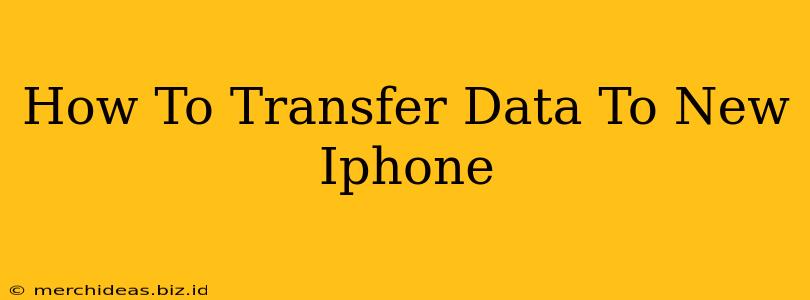Switching to a new iPhone is exciting! But before you dive into exploring its features, you need to transfer all your precious data from your old device. This comprehensive guide will walk you through the easiest and most efficient methods, ensuring a seamless transition to your shiny new iPhone.
Methods for Transferring Data to Your New iPhone
There are several ways to transfer your data, each with its own advantages:
1. Using Quick Start: The Fastest and Easiest Way
Quick Start is Apple's built-in feature designed to make transferring data incredibly simple. It uses Bluetooth and Wi-Fi to wirelessly transfer your information. Here's how it works:
- Power on your new iPhone: Follow the on-screen setup instructions until you reach the "Transfer Data" screen.
- Position your old iPhone: Keep your old iPhone close by. It should display a Quick Start animation.
- Center the animation: Center the animation on your new iPhone's screen to initiate the transfer process.
- Authenticate: You might need to authenticate with Face ID or Touch ID on both devices.
- Choose your data: Select which data to transfer (apps, photos, videos, settings, etc.).
- Wait for completion: The transfer time depends on the amount of data. Be patient and keep both devices close and connected to Wi-Fi.
Pros: Fastest and easiest method, especially for large amounts of data. Wireless, so no cables are required.
Cons: Requires both iPhones to be relatively close and connected to the same Wi-Fi network.
2. Using iCloud Backup: For Wireless Transfer Across Distances
If you're transferring data from an older iPhone that's not physically near your new one, iCloud Backup is your best bet. This method involves backing up your old iPhone's data to iCloud and then restoring it to your new device.
- Back up your old iPhone: Go to Settings > [Your Name] > iCloud > iCloud Backup and tap Back Up Now.
- Set up your new iPhone: Follow the on-screen setup instructions until you reach the "Apps & Data" screen.
- Restore from iCloud Backup: Choose "Restore from iCloud Backup," sign in with your Apple ID, and select your most recent backup.
Pros: Convenient for transferring data across distances, no need for proximity.
Cons: Requires a stable internet connection (Wi-Fi is recommended). Transfer time can vary depending on data size and internet speed. You’ll need sufficient iCloud storage.
3. Using iTunes or Finder (For macOS Catalina and later): A Wired Option
If you prefer a wired connection or are having trouble with wireless methods, iTunes (for older macOS versions) or Finder (macOS Catalina and later) offers a reliable alternative.
- Back up your old iPhone: Connect your old iPhone to your computer and open iTunes (or Finder). Select your iPhone and click "Back Up Now."
- Set up your new iPhone: Follow the on-screen setup instructions until you reach the "Apps & Data" screen.
- Restore from Backup: Choose "Restore from a Mac or PC" and select the backup you just created.
Pros: Reliable method, especially for troubleshooting wireless issues. Potentially faster than iCloud, depending on your internet speed and computer's processing power.
Cons: Requires a computer and a USB cable.
Choosing the Best Method for You:
- Quick Start: Best for a fast, easy transfer when your old and new iPhones are close by.
- iCloud Backup: Ideal for transferring data wirelessly over longer distances, but requires sufficient iCloud storage and a good internet connection.
- iTunes/Finder: Reliable alternative if you encounter problems with wireless methods or prefer a wired connection.
No matter which method you choose, ensure your devices are charged before beginning the transfer process. A little patience will ensure all your data safely arrives on your new iPhone, allowing you to quickly pick up where you left off!
